Remote training has grown increasingly important as more businesses go virtual.
Here’s an 8-step approach to train virtual workers:
- Designate your training team leadership
- Assess your remote training skills gap
- Set measurable training goals
- Select training materials
- Set up your training portal
- Schedule remote training sessions
- Track training progress
- Implement new skills
Learn what remote training is, why it’s important, how to set training goals, what tools you can use and how to put best practices for training remote employees into practice.
What Is Remote Training?
Remote training is the training of off-site workers in a virtual learning environment through digital technology tools. It has a number of major characteristics:
- It can be used to train employees who work from home and employees who work at other remote locations as well as other off-site workers, such as contractors.
- It can serve to reinforce existing skills or to support employee upskilling.
- It can be used to train employees in hard skills such as software use as well as soft skills such as communications.
- It is typically delivered in a virtual environment through digital tools such as online knowledge bases, interactive tutorials, video conferences and webinars.
These characteristics illustrate both how remote training resembles conventional on-site training and how it differs. Remote work training can be used to impart many of the same skills as conventional training, and it can often be conducted using similar methods. However, it is geared toward off-site workers rather than on-site workers, it relies more heavily on digital tools and it may be used to impart certain skills that are unique to a digital environment.
For example, customer service representatives who work from home may use software exclusively designed for a digital workspace.
This combination of similarities and differences means that, while some conventional training methods can be exported to the digital teaching space, others require adaptation to the unique features of the remote virtual training environment.
In particular, instructors must be skilled with the use of training technology and with adjusting to the lack of physical presence in a remote environment. For example, demonstrations must be conducted through virtual tools such as software or video chat rather than through face-to-face interaction.
Why Is Remote Training Important?
Remote virtual training conveys a number of important benefits to organizations:
- It helps you support a remote workforce, increasingly important as more of the economy shifts to a virtual business model
- It reinforces existing skills among remote workers
- It imparts new skills
- It can help you identify and correct frequent employee mistakes
- It can increase employee efficiency
- It supports employee upskilling and promotion
- It promotes higher employee engagement
- It can help you assess skills gaps
These benefits make remote training as important in a virtual work environment as conventional training is in an office setting.

What Are the Goals of Remote Training?
Remote work training proceeds best when you establish clear, measurable goals for your training sessions. You can use key performance indicators (KPIs) to help you define training goals and measure success.
You can use different types of KPIs to set training goals and track progress:
- Desired effect of training on operational performance: for example, sales training might set a goal of raising closing rates for individual sales representatives and for team members
- Delivery of training, such as tracking attendance and hours of training completed per employee and for your team as a whole
- Effectiveness of training on communicating skills, such as using a test assessment tool to establish a satisfactory grade and track what percentage of participants achieve the desired score
- Return on value of training, such as tracking the cost of training as a percentage of payroll
Some remote training tools include built-in analytics tools to help you track training KPIs.
What Are the Best Remote Training Tools?
A wide range of digital tools can serve to aid remote learning:
- Corporate learning management system (LMS) software, a type of application that provides an online portal for instructors to interact with students, share learning materials, administer tests and track results
- Tutorial software designed to help instructors create tutorials
- Video conferencing and webinars, which allow instructors to deliver virtual lectures and share screens and files
- Screencasts, which can be used to record and share videos and slideshows
- Podcasts are useful for delivering instructions that only require audio
- Animation software useful for illustrating instructions
- File-sharing programs used to share training materials
- Screen captures used to share screenshots and illustrate instructions during a remote training session
- Remote desktop software, which allows instructors to perform demonstrations on employee screens
- Online knowledge bases providing the ability to search for answers to frequently asked questions
Select the tools appropriate to your needs. A corporate LMS portal such as Lessonly can serve as a central platform for integrating use of various tools.
What Are Best Practices for Training Remote Employees?
You can increase the effectiveness of your remote training program by following a smart strategy.
Here are 8 top training ideas for remote employees:
1. Designate Your Training Team Leadership
A good training program starts with effective administration and instruction. Start by designating who will lead your training program. Your training team leadership will be responsible for tasks such as setting training goals, selecting training materials, delivering instruction and assessing program effectiveness.
Depending on the size of your staff and your needs, your program may be led by a single individual or by a group of instructors under a designated leader. If you lack the in-house personnel to handle your own training, consider hiring a business training company.
2. Assess Your Remote Training Skills Gap
To identify how training could best benefit your remote team, you can conduct a skills gap assessment. A skills gap assessment seeks to identify which skills your team needs, where you are lacking and which skills represent your highest training priorities. You can conduct a skills gap assessment for individual workers as well as for your team as a whole.
To conduct a skills gap assessment, begin by creating a list of which skills your team needs to perform your company or department’s functions and to carry out the responsibilities of each job position.
You can assign skills a numerical weight to rank them in importance (for example, 1 for low priority, 2 for medium and 3 for high), while also assigning a number to represent your required skill competence (such as 1 for average competence, 2 for good and 3 for excellent). You can then compare this with the skills currently possessed by your staff.
You can use a number of methods to collect the information you need for your assessment:
- Surveys
- Interviews
- Performance reviews
To automate the process of conducting a skills assessment, you can use skills management software, such as Skills DB Pro.
3. Set Measurable Training Goals
Conducting a skills gap assessment positions you to set training goals suitable to your needs. To make your goals measurable, use KPIs as discussed above.
Examples of KPIs you might use include:
- Number of training sessions or hours completed
- Achievement of proficiency with a specific skill or set of skills as measured by a test score
- Post-training improvement of performance as measured by a metric such as tasks completed per hour
Select KPIs relevant to your training goals.
4. Select Training Materials
Successful training depends heavily on the selection of the correct training materials to run a remote training session. For some training topics, such as software training, tutorials may already be available from the manufacturer or other providers. For other topics, you may need to develop your own customized training materials or work with a business training company to obtain or create materials.
Use materials appropriate for the type of skill being taught. For example, if you’re training employees how to use a digital app, an ideal training program would include training materials designed to let employees log into the app, view on-screen demonstrations and practice using app features.
5. Set Up Your Training Portal
A digital training portal, such as an LMS interface, can greatly increase the efficiency of your remote training program. To use a training portal, you typically need to perform certain preliminary tasks, such as:
- Creating accounts for administrators, instructors and participants
- Setting security permissions levels differently for team leaders and participants
- Uploading training materials to be shared with participants
- Selecting KPIs to be tracked by your portal’s analytics tool
- Training administrators and instructors on how to use your portal
For best results, do a test run of your portal before running live training sessions. This will allow your instructional team to work out any bugs ahead of time.
6. Schedule Remote Training Sessions
Once you’ve got your training portal set up, the next step is to schedule your first remote training session. If you’re using an LMS tool, you may have built-in features for scheduling sessions and sending out notifications to participants. Alternately, you can use a calendar tool or your project management tool in conjunction with email or a messaging app to help schedule sessions.
7. Track Training Progress
As employees begin participating in training sessions and programs, you can start tracking their progress using the KPIs you’ve established. This will enable you to verify the completion of training modules and assess skill acquisition. In some cases, you may determine that employees need to repeat training or take other corrective measures, such as receiving some one-on-one assistance.
8. Implement New Skills
To assess the effectiveness of your training program, it’s important to track how participant performance improves after completing training sessions. Give participants an opportunity to put recently learned skills into practice, and monitor the results. This will help participants reinforce and expand on what they’ve learned as well as giving you an opportunity to evaluate their progress.
This is another place where you can use KPIs to monitor the results of your training program. Tracking performance in this manner can help you nurture the development of individual employees as well as assess and improve your training program.
Implement Remote Training to Optimize Your Virtual Workforce
Remote training can help make your virtual workforce more skilled, more engaged and more productive, optimizing your team’s output.
Effective remote training may require an investment in instruction, digital training tools and teaching materials. If you need financing to cover the costs of remote training, consider applying for a working capital loan or another form of small business financing.











